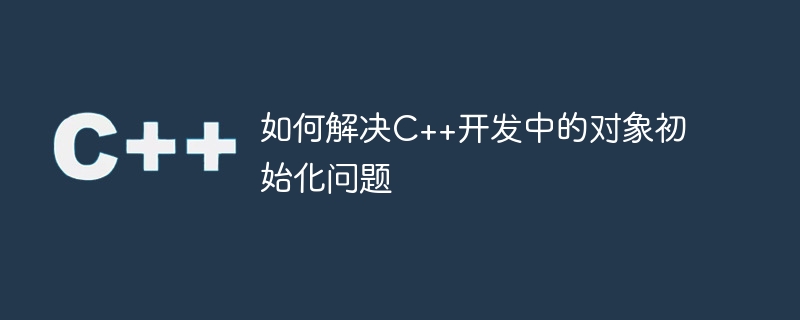Home >Backend Development >C++ >How to solve object initialization problems in C++ development
How to solve object initialization problems in C++ development
- WBOYWBOYWBOYWBOYWBOYWBOYWBOYWBOYWBOYWBOYWBOYWBOYWBOriginal
- 2023-08-22 16:03:471464browse

How to solve the object initialization problem in C development
Introduction:
In C development, object initialization is a very important link. Proper object initialization ensures program correctness and performance. However, object initialization issues in C are relatively complex and prone to various errors. This article will introduce some methods to solve object initialization problems in C development.
1. Basic concepts of object initialization
In C, object initialization is the process of creating an object and allocating memory space for it. Object initialization is divided into two steps: allocating memory and constructing the object. Allocating memory refers to allocating the required memory space for the object, while constructing the object refers to initializing the member variables of the object and calling the constructor.
2. The role of the default constructor
The default constructor is a special constructor with no parameters and no return value. When we do not define a constructor for a class, the compiler automatically generates a default constructor. The default constructor is used for the default initialization of the object, which is automatically called when the object is declared to initialize the default values of the member variables. If we customize the constructor, the compiler will not generate a default constructor.
3. Explicit initialization and implicit initialization
In C, objects can be initialized through explicit initialization and implicit initialization. Explicit initialization refers to explicitly initializing member variables by using the assignment operator or curly braces when defining the object. Implicit initialization means that member variables are not explicitly initialized when defining an object, and the compiler automatically calls the constructor for implicit initialization.
Explicit initialization example:
class MyClass {
int num;
public:
MyClass(int n) : num(n) {}
};
int main() {
MyClass obj(10); // 显式初始化
}Implicit initialization example:
class MyClass {
int num;
public:
MyClass(int n) : num(n) {}
};
int main() {
MyClass obj = MyClass(10); // 隐式初始化
}4. Initialization sequence of member variables
In explicit initialization and implicit initialization, Member variables are initialized in the order they are declared in the class. If the member variables of a class depend on the value of another member variable, the order in which they are initialized is very important.
5. Constructor initialization list
Constructor initialization list is a special syntax used when defining a constructor. It is used to explicitly initialize member variables. Using a constructor initialization list can improve the efficiency of your code and avoid some object initialization problems.
Constructor initialization list example:
class MyClass {
int num;
int square;
public:
MyClass(int n) : num(n), square(n * n) {}
};6. Life cycle of objects
The life cycle of an object refers to the entire process from creation to destruction of the object. In C, the lifetime of an object depends on its scope and storage method.
7. Avoid secondary initialization of objects
In some specific scenarios, we need to avoid secondary initialization of objects. For example, when creating and destroying objects in a loop, we can lift the object outside the loop to avoid repeated construction and destruction operations.
8. Use RAII technology to manage resources
In C, we often need to manage resources, such as memory, files, etc. RAII (Resource Acquisition Is Initialization) is an important technology that can effectively avoid resource leak problems by acquiring resources in the object's constructor and releasing them in the destructor.
9. Summary
Correct object initialization is an important part of C development and determines the correctness and performance of the program. The object initialization problem can be better solved through methods such as explicit initialization, constructor initialization list, and avoiding secondary initialization. At the same time, rational use of RAII technology to manage resources can effectively avoid resource leakage problems. Developers need to have a deep understanding of object initialization issues and pay attention to details in actual development to be standardized and efficient.
Conclusion:
This article introduces some methods to solve the problem of object initialization in C development. I hope that after studying this article, readers can correctly use object initialization technology in actual development and improve the readability and performance of the code. At the same time, we also hope that readers can further study and explore C object initialization issues and continuously improve their development capabilities.
The above is the detailed content of How to solve object initialization problems in C++ development. For more information, please follow other related articles on the PHP Chinese website!

